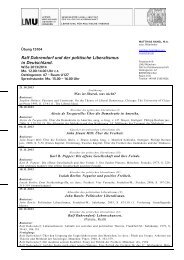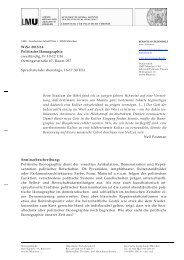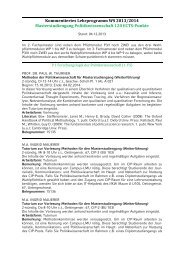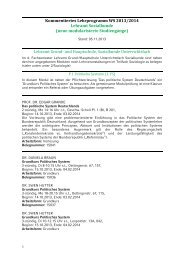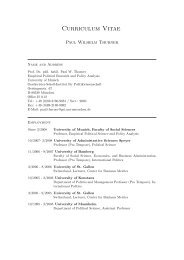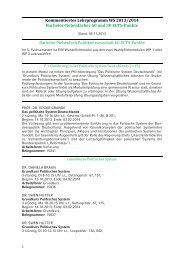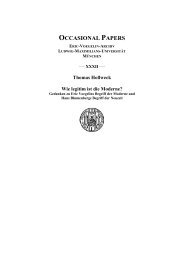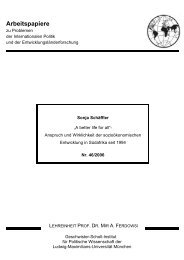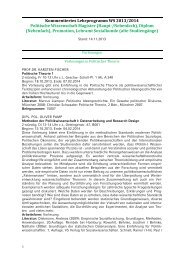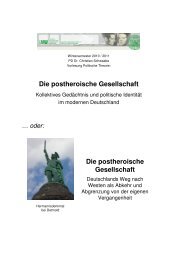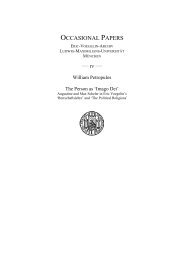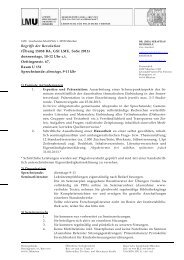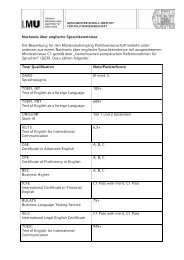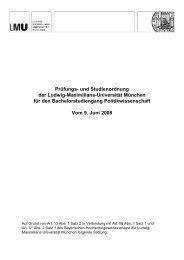THOMAS HOLLWECK is Associate Professor of German at
THOMAS HOLLWECK is Associate Professor of German at
THOMAS HOLLWECK is Associate Professor of German at
You also want an ePaper? Increase the reach of your titles
YUMPU automatically turns print PDFs into web optimized ePapers that Google loves.
– 29 –<br />
preserves the order <strong>of</strong> things.“ 41<br />
The two languages and the correl<strong>at</strong>ive two modes <strong>of</strong><br />
transcendence experienced as the presence <strong>of</strong> the Beyond on<br />
the one hand and the abysmal depth <strong>of</strong> the past <strong>of</strong> Genes<strong>is</strong><br />
provide the m<strong>at</strong>rix from which ar<strong>is</strong>e all possible responses to<br />
reality as such. Th<strong>is</strong> m<strong>at</strong>rix does not separ<strong>at</strong>e the two modes<br />
and their responsive languages cleanly but more <strong>of</strong>ten than not<br />
presents a composite th<strong>at</strong> may please the poet but leaves the<br />
philosopher less than s<strong>at</strong><strong>is</strong>fied. Yet the m<strong>at</strong>rix <strong>is</strong> not the result<br />
<strong>of</strong> a logical incongruity but represents the ambiguity <strong>of</strong><br />
ex<strong>is</strong>tence itself. It represents a problem th<strong>at</strong> <strong>is</strong> not about to go<br />
away <strong>at</strong> a time when we have become so unsure <strong>of</strong> the st<strong>at</strong>us<br />
<strong>of</strong> experiences <strong>of</strong> transcendence altogether.<br />
Applied to the question <strong>of</strong> the Gnostic myth, however, the<br />
insight into the dual ways <strong>of</strong> symbolizing transcendence<br />
becomes crucial. For it provides us with the key to an<br />
understanding <strong>of</strong> the <strong>at</strong>traction <strong>of</strong> Gnostic<strong>is</strong>m to the art<strong>is</strong>t in<br />
general and the poet in particular. Since the art<strong>is</strong>t’s language <strong>is</strong><br />
the mythical language <strong>of</strong> cre<strong>at</strong>ion – even today –, the alien<strong>at</strong>ed<br />
art<strong>is</strong>t, the Gnostic poet, whose immedi<strong>at</strong>e experience <strong>of</strong> divine<br />
reality <strong>is</strong> in stark contrast to the equally strong absence <strong>of</strong> the<br />
divine from the world has to fall back on the language <strong>of</strong> the<br />
Beginning because the reality <strong>of</strong> immedi<strong>at</strong>e divine presence <strong>is</strong><br />
in contradiction to the immanent world surrounding us.<br />
The Gnostic, whether ancient or modern, ex<strong>is</strong>ts in the cold<br />
reality <strong>of</strong> a world from which God <strong>is</strong> absent and which in fact<br />
<strong>is</strong> constructed in such a manner as to prevent man from uniting<br />
with the reality <strong>of</strong> the Beyond. Redemption becomes a m<strong>at</strong>ter<br />
41 Eric Voegelin, The Ecumenic Age, Volume IV <strong>of</strong> Order and H<strong>is</strong>tory,<br />
B<strong>at</strong>on Rouge: LSU Press, 1974, 17 f.



